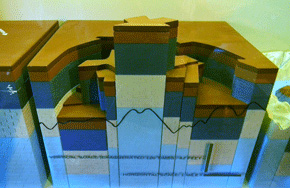SERPENT MOUND
THE CRYPTO-EXPLOSION CRATER
The valley beneath the effigy is really the western rim of a mysterious, four-mile-wide, circular
crater – the eroded remains of a huge, catastrophic event geologists call “The Serpent Mound Disturbance.”
About 300 million years ago, either an asteroid collision or an underground explosion blew apart more than seven
cubic miles of rock. The central area was uplifted more than 1000 feet, while an outer rim
dropped more than 400 feet.
What we see today results from eons of erosion, although the shattered fragments of the “Central Uplift”
remain among the hills above Serpent Mound. The distant ridge tops, visible from the overlooks, stand high
today because they are the much harder Ordovician bedrock that was offset by the event.
The strange geology of this spot was first noticed in modern times by Dr. John Locke of Cincinnati, who named
it “Sunken Mountain” in 1838. Yet, it’s not hard to imagine that the ancient effigy builders could have recognized
the unusual land forms. The serpent looks out from the edge of the Central Uplift zone.

A model in the Serpent Mound Museum shows the scope of the geological disturbance underneath the effigy.


